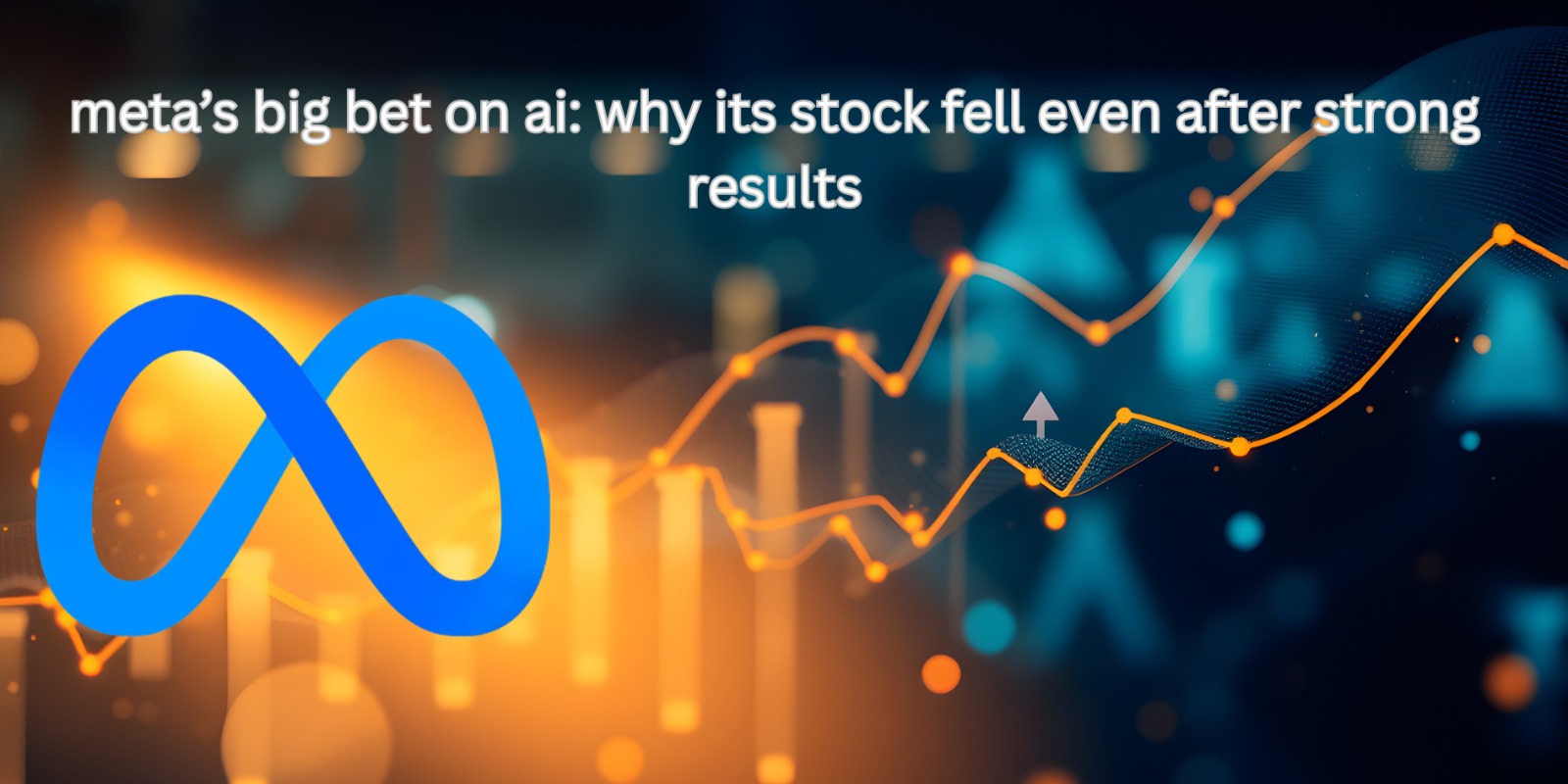Table of Contents
Imagine you run the world’s most popular treehouse club—everyone’s hanging out, having fun, and you’re earning big. Then you decide to build an enormous new treehouse extension with fancy gadgets, and you tell your friends who helped pay for it: “It’s going to cost a lot, but it will be worth it later.” Some of your friends cheer for the vision. Others get nervous about the cost. That’s a lot like what’s happening at Meta Platforms Inc.
Meta just reported a strong quarter: big revenue, lots of users. But investors got worried when Meta said its expenses are going up smaller trees to giant trees by 2026. Because of that, the stock—what you could think of as “shares in the club” value—fell.
In this blog, we’ll talk about:
- What Meta’s results were
- Why investors reacted the way they did
- What’s driving the higher expenses
- What this means for Meta and its users
- What should people watch next?
1. Meta’s Strong Quarter: Good News First
Meta posted some very good numbers:
- Revenue (money coming in) grew 26% compared to the same period last year.
- They had 3.54 billion daily active users across apps like Facebook, Instagram, WhatsApp, and Threads, up 8% year-over-year.
- For the July-September period, they earned $2.71 billion, or about $1.05 per share. Excluding some special costs, they would have earned more.
So, on the surface, Meta is doing well: growing users, growing revenue. That’s good for any company.
2. The Surprise: Why the Stock Fell
Despite the good numbers, Meta’s shares dropped sharply (around 7.7%) after the market closed. Why? Because of what came next: the warning.
Meta told investors that expenses in 2026 are expected to grow much faster than this year. They pointed to big cost drivers like:
- Infrastructure (data centers, servers, AI compute power)
- Employee compensation, especially for AI and technical experts
- Capital expenditures (big investments in property, equipment)
Even though revenue is strong now, the concern is: if costs balloon and returns don’t match quickly, profits could shrink. Many investors saw this as a risk.
3. What’s Driving the Big Expense Increase?
Here’s a breakdown of what Meta said is causing the rising costs:
A. Infrastructure & Compute Power
To build and run advanced AI systems, Meta needs lots of computers, energy, and cooling—all of which cost money. They’re preparing to scale up heavily.
B. Hiring Top AI Talent
Meta is hiring highly paid AI engineers, researchers, and technical teams. Their compensation is cited as one of the largest cost contributors.
C. Capital Expenditures (Capex)
Capex means big investments—buying equipment, building data centers, etc. For 2025, estimates put Meta’s capex around $70–72 billion. For 2026, some analysts believe expenses could be close to $97 billion or more.
D. Legal & Regulatory Risks
Meta also warned about legal issues—antitrust investigations, youth-related lawsuits, and regulatory pressure in the U.S. and EU. These can increase costs or reduce revenue in the future.
4. Why Investors Got Nervous
When you invest in a company, you’re hoping for more profit, not just more revenue. Here’s why the scenario made investors pause:
- Profit margin risk: If costs go up much faster than revenue, profit per dollar earned shrinks.
- Return on investment delay: Big infrastructure and talent investments may take years to pay off. Meanwhile, expense hits now.
- Uncertainty: New AI initiatives are exciting, but they come with risk—will they succeed? Will users adopt? Will competition win?
- Scale of spending: When a company says it may spend tens of billions more in the next year, that’s a big number to wrap your head around.
5. What It Means for Meta & You
If you use Meta apps or follow tech trends, here are key takeaways:
- Meta is doubling down on AI. The company believes that advertising alone isn’t enough; they need AI to fuel future growth.
- For users: Some features powered by AI might improve (for example, better personalization, ads that feel smarter, new tools).
- For society: Big spending on AI infrastructure means Meta expects AI to be a major part of the future of how we connect, share, and maybe even everyday tasks.
- For investors or someone thinking about tech careers: If AI talent is so in demand that compensation is driving costs, then skills in AI and related fields may become highly valuable.
- On the risk side: If these investments don’t pay off, Meta may face slower growth, pressure on profits, or must change strategy.
6. What Should We Watch Next?
Here are some items to keep an eye on going forward:
- Next-quarter revenue vs cost: Is Meta able to keep growing revenue while managing cost growth?
- AI monetization: Are the AI investments translating into new services, higher spending per user, or new revenue streams?
- Capex and expense guidance: Does Meta lower or raise its cost expectations again?
- Legal & regulatory outcomes: Lawsuits or antitrust decisions could impact Meta’s structure or business model.
- Competition & innovation: How do rivals (like Google, Microsoft) fare with their AI investments, costs, and returns?
Conclusion
Meta’s recent quarterly report shows a company in a strong position, with growing users, healthy revenue, and ambitious goals. But with those ambitions come big costs—and that has made investors cautious. The company is spending huge amounts on AI infrastructure and talent, signaling that it sees the future in a major shift toward intelligent systems and platforms.
For you, the takeaway is this: even companies that seem to be winning today are making big bets on tomorrow. Some bets will pay off, others may not. Watching how Meta manages its costs, how its AI vision unfolds, and how market confidence holds up will reveal a great deal about the future of technology.
Life—and business—is about growth and sustainability. Meta’s story reminds us: big dreams are exciting, but big expenses need big returns.



































